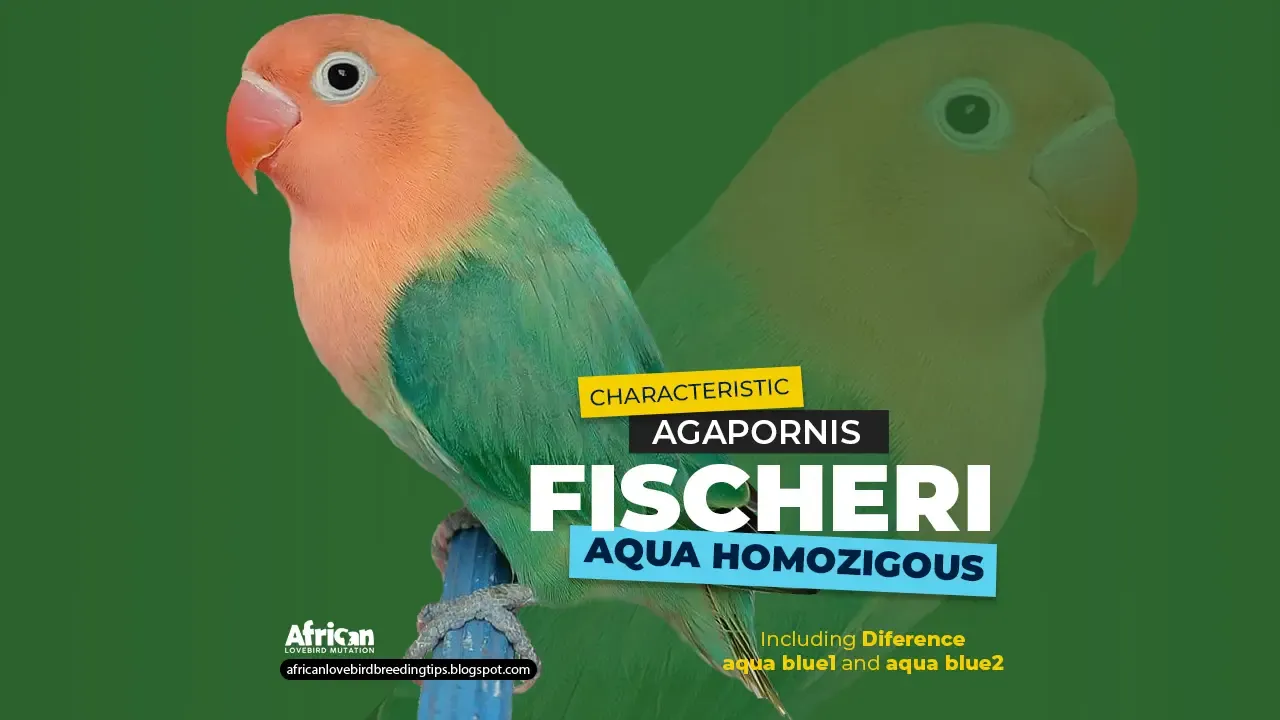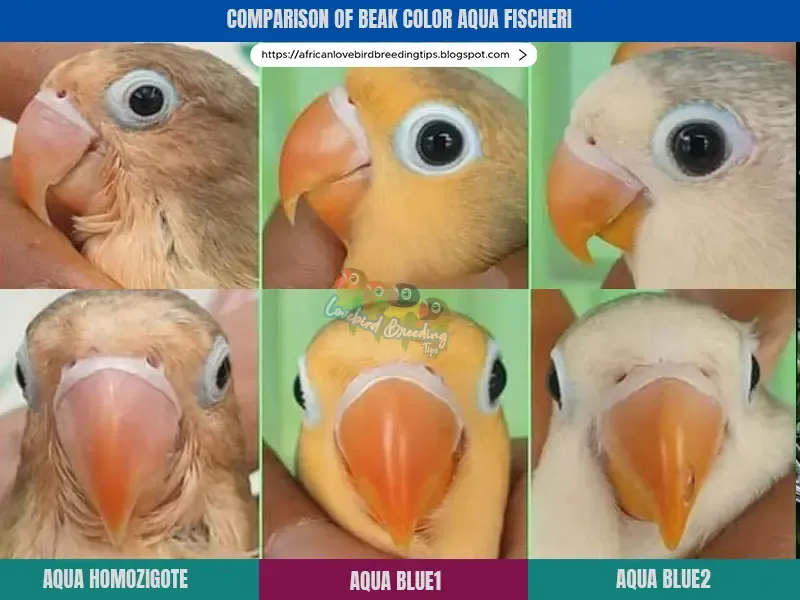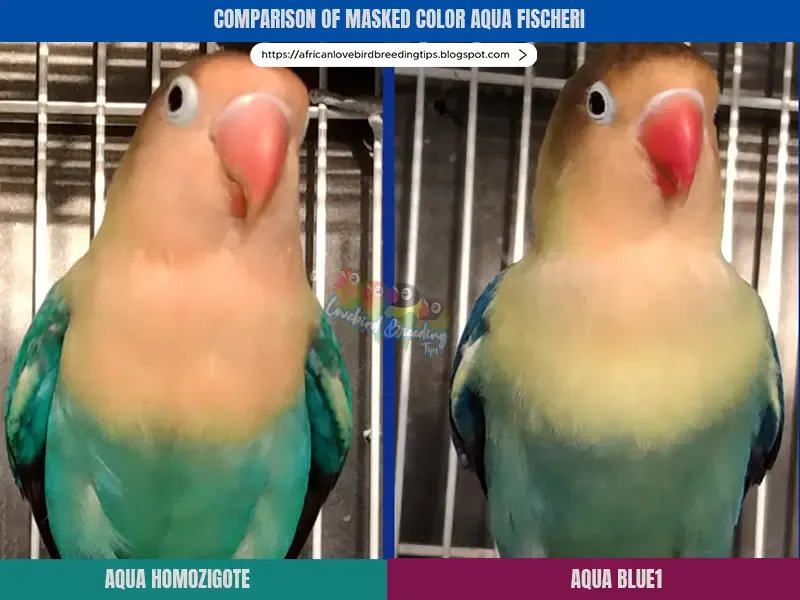
Agapornis fischeri Aqua Homozygous is another variant of the fischeri aqua mutation. It is named for the phenotype
resulting from an aqua x aqua cross. It is not specified which Aqua is being referred to.
However, some sources say homozygous Aqua must be obtained from an aqua blue1 x aqua blue1 cross. Is this a trade
name, or is homozygous Aqua a genuine aqua where a newly discovered mutation must separate homozygous phenotypes?
As most people post on social media, I have experimented with several aqua x aqua pairs that did not get the
homozygous aqua phenotype chicks.
Table of Contents
Some chicks actually reverted back to blue1blue2. My crossing scenario needed to be corrected, or there are other influencing factors that I am still studying. It is also possible that the Aqua I have from the pedigree is close to blue1blue2.
If this question has so far arisen in the bird Agapornis fischeri (eye-ring species), is the mutation assumed: A.AquaBlue1B.AquaBlue2 is a
combination of mutations(multiallel) of bl-locus?! Then, it will raise a "rooted" question of whether there is a
Visual "Aqua" Homozygote without the combination of mutations "Blue1 and Blue2"?
Of course, that question can be equally "broken down" from the breeding tests that we do. So far, breeders
have paired the A and B "mutations" above with Bl-locus mutations (Blue1Blue2, Blue2, and Blue1).
From these
pairs, it is challenging to track whether there is an "Aqua" mutation that we assume to be a Homozygote.
To
make it easier in terms of language, let's see this breakdown together:
Crossing AquaBlue1 with :
1.Blue1
2.Blue2
3.Blue1Blue2
4.AquaBlue1
5.AquaBlue2
The assumption of "probability" that chicks will appear is:
1. AquaBlue1 x Blue1 =50% AquaBlue1 (Orange beak) 50% Blue1 (Ivory white beak)
2. AquaBlue1 xBlue2=50%
AquaBlue2 (Ivory white beak) 50% Blue1Blue2 (Orange Beak, with a solid Orange forehead)
3. AquaBlue1 x
Blue1Blue2 =25% AquaBlue1 (Orange Beak) 25% AquaBlue2 (Ivory white beak) 25% Blue1 (Ivory White Beak) 25%
Blue1Blue2 (Orange Beak, with intense Orange forehead)
4. AquaBlue1 x AquaBlue1 =25% Aqua (Homozygote)
Visuals still under the "assumption" of an Orange beak like AquaBlue1 visuals 50% AquaBlue1 (assumption = This visual
is the same as the Aqua homozygote visual) 25% Blue1 (Ivory White Beak)
5. AquaBlue1 x AquaBlue2 =25% Aqua
(homozAquae). The visual is still assuming an Orange beak like the AquaBlue1 visual: 25% AquaBlue2 25%
AquaBlue1 25% Blue1Blue2.
At points 4 and 5, we can get homozygote genetic chicks. Still,
there is a problem faced: the visual is challenging to recognize because of the "assumption" that the aqua
homozygote is the same as the AquaBlue1 visual, whereas, at points 4 and 5, there is a chance of appearing
AquaBlue1 and Aqua Homozygote.
That means the above method will complicate identifying "homozygote and
heterozygote." Is there another way to test breeding to quickly get aqua "homozygote" without having to
test breeding again (to distinguish homozygote and Heterozygote)?
There are two ways :
25% aqua
homozygote (with a note that the two parents above must have previously tested breeding with Blue1 to print
AquaBlue1)
b. AquaBlue2 x AquaBlue2 = 25% Aqua (Homozygote) => Orange Beak 50% AquaBlue2 (Ivory White
Beak) 25% Blue2 (Ivory White Beak)
Apart from homozygous aqua naming, from a phenotypic view, it is indeed
different from aqua blue1 and aqua blue2. For this reason, this article will discuss some essential characteristics of
aqua homozygotes.
Characteristics of the Agapornis fischeri Aqua Homozygous Mutation
Let's learn about the characteristics of the Agapornis Fischeri Aqua Homozygote, from the color of its body feathers, beak, mask, and tail to how it is genetically inherited.Beak color of fischeri aqua homozigous
If aqua blue1, the beak color tends to be reddish orange, while aqua blue2 is ivory white. Homozygous aquas have an intermediate beak color.

It resembles the beak color of blue1/series blue against the background of skin color. Beak color is also
influenced by where the bird comes from.
There is a color difference between the Aqua blue1 x Aqua blue1 cross and
Aqua blue2 x Aqua blue2. If it is indeed a homozygous aqua, it must be obtained from the double-factor aqua allele.
Head and Masked color of Fischeri aqua homozygous
The big difference lies in the mask area of the homozygous Aqua compared to Aqua variants. The base of the homozygous aqua mask is peach.

The mask's color also spreads more to the breast area. There is almost no degradation, especially for mutations that reduce melanin. Also, if combined with homozygous Aqua, opaline will have a peach color on the entire head.
Tail patern color of fischeri aqua homozigous
Like other PPR (Partial Psittacine Reduction) mutations such as blue1, blue2, and blue1blue2/parblue, homozygous Aqua's tail pattern Aqua will follow the head's peach color.
One thing to note is that the peach color is not absolute; it depends on the aqua blue1 or aqua blue2 double allele Aqua.
